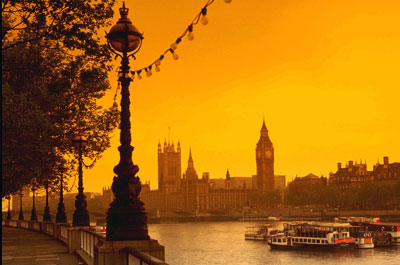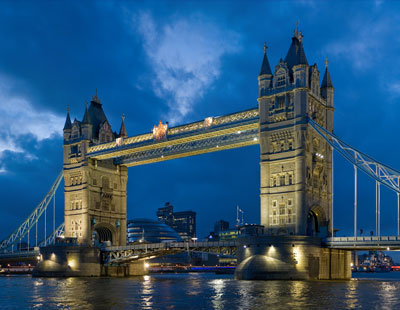United Kingdom
Country statistics

Land area: 93,278 sq miles (241,590 sq km)
Total area: 94,526 sq miles (244,820 sq km)
Population (2010 est.): 61,284,806 (growth rate: 0.2%); birth rate: 10.6/1000; infant mortality rate: 4.7/1000; life expectancy: 79.1; density per sq km: 246
Capital City: London
Monetary unit: Pound sterling (£)
Languages: English, Welsh, Scots Gaelic
Ethnicity/race: English 81.5%; Scottish 9.6%; Irish 2.4%; Welsh 1.9%; Ulster 1.8%; West Indian, Indian, Pakistani, and other 2.8%
Religions: Anglican and Roman Catholic 40 million, Muslim 1.5 million, Presbyterian 800,000, Methodist 760,000, Sikh 500,000, Hindu 500,000, Jewish 350,000
Country introduction

The United Kingdom of Great Britain and Northern Ireland is commonly known as the United Kingdom (UK) or Britain and is a sovereign state located off the north-western coast of continental Europe. The United Kingdom consists of Great Britain (England, Scotland and Wales), plus the six counties of Northern Ireland. The Isle of Man and the Channel Islands (principally Jersey and Guernsey) are also parts of the British Isles, but not officially part of the UK. Apart from this, the UK is also surrounded by the Atlantic Ocean, the North Sea, the English Channel and the Irish Sea.
Most of England consists of rolling lowland terrain, divided east from west by more mountainous terrain in the north-west and north and limestone hills of the Peak District by the Tees-Exe line. The largest urban area is Greater London, which covers an area of 980 sq km (609 sq miles). Its primary geographical feature is The Thames, a navigable river which crosses the city from the south-west to the east. The main rivers and estuaries are the Thames, Severn and the Humber Estuary. Near Dover, the Channel Tunnel links the United Kingdom with France.
Scotland's geography is varied, with lowlands in the south and east and highlands in the north and west, including Ben Nevis, the highest mountain in the British Isles at 1,344 m (4,408 ft). There are many long and deep-sea arms, firths, and lochs. Scotland has nearly 800 islands, mainly west and north of the mainland, notably the Hebrides, Orkney Islands and Shetland Islands. The capital city is Edinburgh, the centre of which is a World Heritage Site. The largest city is Glasgow.
Wales is mostly mountainous, the highest peak being Snowdon at 1,085 m (3,560 ft) above sea level. North of the mainland is the island of Anglesey. The largest and capital city is Cardiff, located in South Wales.
The culture

Despite its relatively small size, the United Kingdom is one of the most culturally diverse countries in the world, peopled by four main 'native' nationalities, plus later arrivals from all over the world.
It is a European state, and has many cultural links with its former colonies, particularly those that use the English language (the Anglosphere). Considerable contributions to British culture have been made over the last half century by immigrants from the Indian Subcontinent and the West Indies. The origins of the UK as a political union of formerly independent states has resulted in the preservation of distinctive cultures in each of the home nations.
The United Kingdom contains two of the world's most famous universities, the University of Cambridge and the University of Oxford, and has produced many great scientists and engineers including Isaac Newton, James Watt, Charles Darwin, and Isambard Kingdom Brunel. A great number of world-changing inventions or discoveries were made by British people, including: Michael Faraday, Frank Whittle, Charles Babbage, Robert Baden-Powell, Alexander Fleming, John Logie Baird, William Caxton, Richard Trevithick, Humphry Davy, Robert Watson-Watt, Henry Bessemer, Tim Berners-Lee and others
Also, a great number of the world's major sports originated in the United Kingdom, including: football, golf, boxing, rugby, cricket, snooker, billiards, badminton and curling.
United Kingdon is also home to playwright William Shakespeare, arguably the most famous writer in the world.
Attractions & landmarks

London is a major tourist destination, some of the most exciting and interesting attractions in the world. From top museums which cover a range of topics to some fascinating historic buildings and monuments, there is something to please every visitor. There are approximately 238 attractions in London that are free to enter.
Some iconic landmarks include The Houses of Parliament, Buckingham Palace, Big Ben, Trafalgar Square, Westminster Abbey, Piccadilly Circus and St. Paul's Cathedral. Buckingham Palace in particular will allow visitors to see the changing of the Guards and even in August and September the palace itself is open to visitors. Other must-see London sights include the Tower Bridge and nearby Tower of London, British Museum and the Princess Diana Memorial. There are also many modern landmarks in London including the Canary Wharf, London Eye and the Shard, a new skyscraper which began construction in March 2009. Recently, the London Olympic Stadium became a focal point of the London 2012 Olympic Games and the stadium quickly became an iconic part of the city's landscape.
The largest parks in the central area of London are the Royal Parks of Hyde Park, its neighbour Kensington Gardens at the western edge of Central London and Regent's Park on the northern edge. Regent's Park contains London Zoo, the world's oldest scientific zoo, and is located near the tourist attraction of Madame Tussauds Wax Museum. Closer to Central London are the smaller Royal Parks of Green Park and St. James's Park. Hyde Park in particular is popular for sports and sometimes hosts open-air concerts. Primrose Hill to the north of Regent's Park is a popular spot to view the city skyline. Also a popular attraction is The Royal Botanic Gardens at Kew which has about 50,000 plant species and many historically significant buildings such as the Palm House and Temperate House.
There are over 240 museums in London, including the British Museum, the Science Museum, the Natural History Museum and Victoria and Albert Museum. Following the removal of admission charges, attendances at London museums increased, with a large percentage of the 42 million annual visitors nationwide. Many also flock to the West End theatres and the shopping areas of Knightsbridge, Oxford Street and Regent Street.
Within easy day-trip distance of London are the university cities of Oxford and Cambridge, the picturesque Cotswolds with their many pretty villages, Stratford-upon-Avon (home of William Shakespeare), the cathedral at Canterbury and the seaside attractions of Brighton.
Further afield lie delights like Cornwall (to the south-west), Yorkshire, Durham, Northumberland and Cumbria (a large part of which constitutes the Lake District). Wales adjoins England to the west, and offers, in addition to its populous southern cities, a diverse range of historic castles, spectacular coastlines and impressive mountain landscapes.